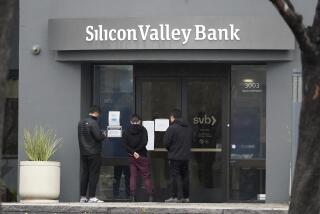Guardian Chief Tried to Make S&L; Worker-Owned : Thrift: The plan, rejected by regulators, called for control by minorities and a $25-million ante by the federal government.
- Share via
The chairman of Guardian Savings & Loan tried to interest regulators last month in a plan to turn the failed Huntington Beach thrift into an employee-owned, minority-controlled financial institution.
But the federal government, which seized the S&L; in June, would have had to put up $25 million to make the deal go through, and “there’s no money for that,” William J. Crawford, the thrift’s chairman and president, said Wednesday.
Crawford, a former commissioner of the state Department of Savings and Loans, said the thrift will probably be liquidated or sold at a loss by the Resolution Trust Corp. The RTC is the federal agency that manages and liquidates failed thrifts.
Crawford disclosed his effort to save the thrift and the jobs of its 430 employees after L. William Seidman, chairman of the Federal Deposit Insurance Corp., talked about the plan in a telephone interview Wednesday.
Seidman is also the chairman of the RTC, which has been managing Guardian since regulators seized it June 21. The RTC has retained Crawford and his top aide, William D. Davis, another former state commissioner, in their posts.
“The plan would have taken substantial financial support from the RTC to save it rather than have us take it over and liquidate it,” Seidman said. “Essentially, the plan called for a note that would be paid off over time.”
Seidman said Crawford sent him a description of what he wanted to do and then came to see him in Washington about a month ago to pitch the idea.
“The last I knew,” Seidman said about the plan, “it didn’t look viable.”
Crawford’s plan would have given the thrift to the employees, who would have paid for it by setting aside 4% of their net income in an employee stock option plan to pay off the $25-million promissory note from the federal government over the next five years. Three-quarters of the thrift’s board would have been members of minority groups, and no shareholder would have owned more than 1% of the S&L.;
In the meantime, he said, Guardian’s earnings over the next five years would have been put into its capital base--its final reserve against losses--and that would have brought the S&L; above federal requirements for capital levels. At the time regulators took over the institution in June, Guardian was still solvent, but its capital had fallen well below required levels.
“This was my idea of a way to preserve jobs for employees,” Crawford said. “It doesn’t affect me. I’m 71. I won’t be around in five years or so. It also would have avoided a loss for taxpayers.”
The thrift has long catered to minorities and minority communities, he said. About 41% of Guardian’s work force consists of minorities, chiefly Latinos and Asians, and about 52% of its loans are for housing in minority communities, he said.
Crawford of Newport Beach took over as Guardian’s top officer in February to try to save the institution after federal regulators ousted the S&L;’s sole owner, Russell M. Jedinak, from management and board positions. Davis of Villa Park joined in May as chief operating officer.
Regulators charged that Jedinak had not maintained the thrift’s books properly, had inadequate internal controls to detect fraud, mismanagement or poor loan prospects. They also charged that the thrift had an outdated and inadequate management structure.
Crawford said Wednesday that Guardian’s basic home-loan business was good but that its operating policies and procedures, especially internal controls to improve loan documentation, were needed to identify possibly bad loans before they were made.
More to Read
Inside the business of entertainment
The Wide Shot brings you news, analysis and insights on everything from streaming wars to production — and what it all means for the future.
You may occasionally receive promotional content from the Los Angeles Times.










